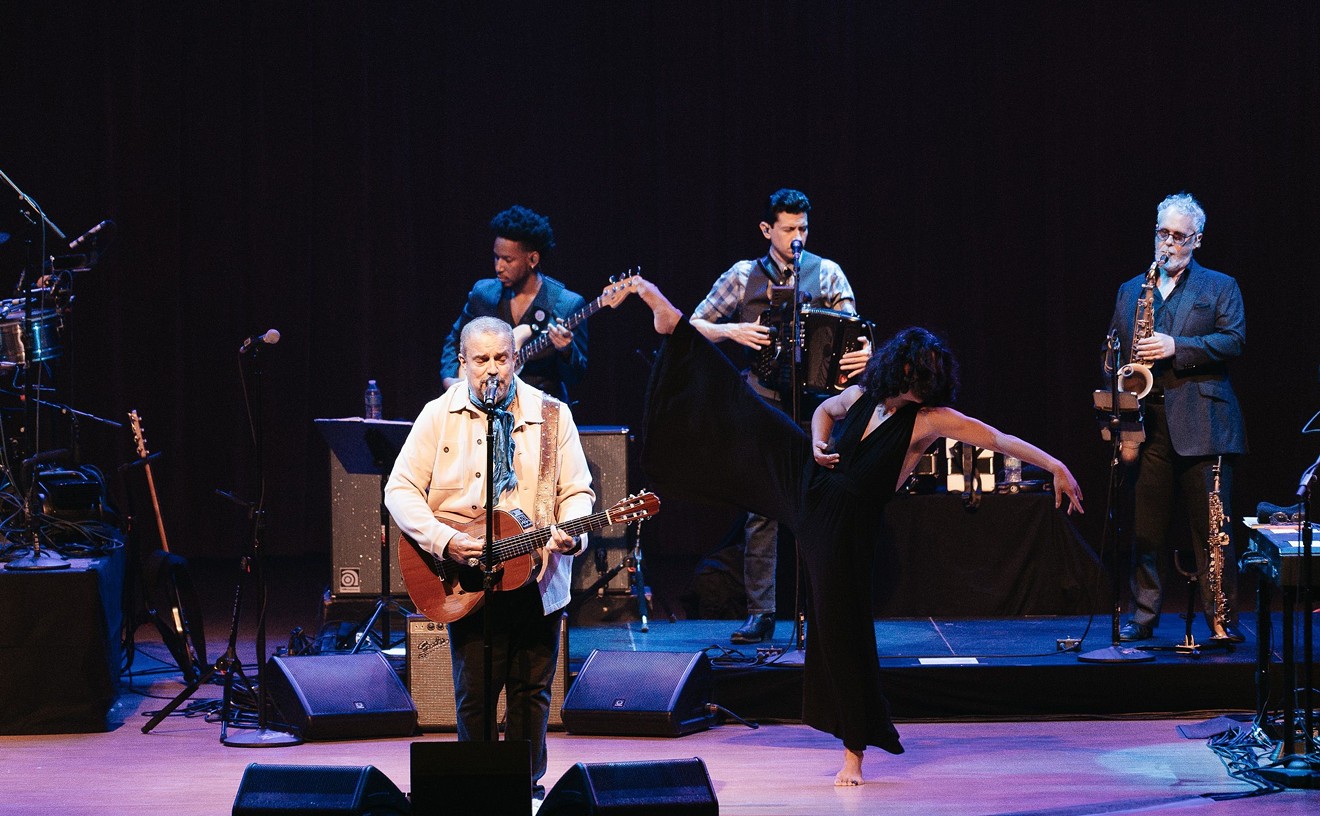Americans who still think of Latin music as mariachi bands and gyrating Ricky Martins and Shakiras might want to lend a closer ear to the genre. This country's Hispanic population isn't just growing, it's growing more diverse. More and more unique musical styles are being gobbled up, and that should come as good news to alternative gringos hoping to spruce up their castellano. This year's Latin-music highlights come from all over the Spanish-speaking map. We'll start in the farthest geographic corner: an island in the Mediterranean.

BUIKA
Niña de Fuego
(WEA International)
Afro-Spanish artist Buika epitomizes cultural and ethnic diversity. Over three decades ago, her parents fled political turmoil in the former Spanish colony of Equatorial Guinea and made a new life for themselves in a gypsy neighborhood on the island of Mallorca. After stints as a Tina Turner impersonator in Vegas and as the vocalist on some chic house and funk albums made for the European clubs, Buika has found her niche in flamenco and Latin jazz. This year's Niña de Fuego contains many of the same gitano elements found on her successful LP Mi Niña Lola, and pushes the boundaries further by adding Mexican ranchera. Only someone as strangely bohemian as Buika could pull together these emotive styles with just the right amount of melodrama.

THE PINKER TONES
Wild Animals
(Nacional)
Barcelona's Pinker Tones have traded most of their native Catalán for English -- both in language and in beat. On Animals, harmonic backing vocals combine with synthesizers and wah-wah pedals to produce 1980s-style pop and rock steady. The song titles couldn't be more fitting. "Hold On" starts with a choir and then hits the gas with an accelerated Beck-like groove. That's followed by the even more retro number "S.E.X.Y.R.O.B.O.T." and the happy-go-lucky reggae track "The Whistling Song." But Pinkertones do take pride in some forms of hip-swiveling: Be prepared to shake your mod booty to "Electrotumbao."

FITO PÁEZ
Grandes Canciones
(Sony International)
Going even more retro is Argentina's legendary Fito Páez. A pioneer of
pop rock en español, Páez waxes nostalgic on this greatest-hits album.
Millions of South American rockers are sure to hold up their lighters,
arena-style, to the memories conjured up by Páez's whimsical
combination of piano and poetic lyrics on songs like "La Rueda Mágica"
and "Mariposa Tecknicolor."

BAJOFONDO
Mar Dulce
(Decca)
Since dropping the "Tango Club" title from its name, this
electronic-music collective has broadened its musical horizons. They
now include the African rhythms of Uruguay's candombe, Andalusian
hip-hop as presented by Spain's La Mala Rodríguez, and a healthy
sampling of North and South American pop and blues, represented here by
contributing artists such as Britain's Elvis Costello, America's Nelly
Furtado, Mexico's Julieta Venegas, Argentina's Gustavo Cerati and
Uruguay's Jorge Drexler. The movie-like symphonics are enough to liven
the winter doldrums of any holiday party.

BABASÓNICOS
Mucho
(Universal Latino)
Yet another Argentine outfit manages to walk the line between
commercial pop and alternative rock. Babasónicos' Mucho has much to
offer a wide range of listeners, with a sound reminiscent of the late
1980s and early '90s, when the group first experienced success. The
opening tune, "Yo Anuncio," sounds like a bit like Jellyfish, while
"Pijamas" is a reminder of the new-wave movement, and "Estoy Rabioso"
packs enough punch to generate a relatively safe mosh pit. Gotta
carpool or share the stereo with officemates? This album is likely to
keep the masses pleasant in tight quarters.

ATERCIOPELADOS
Río
(Nacional)
Travel to Colombia and pop life gets even funkier. On Río, it's evident
that Aterciopelados haven't forgotten their indigenous, rebellious
urban roots. As always, frontwoman Andrea Echeverri's slightly nasal
voice harmonizes divinely over a cool collection of alt-rock laced with
reggae, cumbia and other Andean styles. The band undulates from spacey
and mysterious to hard-driving and happy as it tackles everything from
motherhood ("28") to immigration ("Bandera").

CALLE 13
Los de Atrás Vienen Conmigo
(Sony International)
Puerto Rico's five-time Grammy and Latin Grammy award-winning veterans
segue from straightforward hip-hop to an alternative reggaetón that
incorporates everything from rock steady to cumbia. It's ballsy to the
point of requiring a parental advisory, but nonetheless thoughtful in
the way it busts out ironic chants and ragamuffin rhymes. Given the
band's dark humor, it's not surprising that this album received musical
contributions from cheeky Panamanian salsa god Ruben Blades on "La
Perla Feat" or legendary Mexican rockers Café Tacuba on "No Hay Nadie
Como Tú."

ORISHAS
Cosita Buena
(Phantom Sound and Vision)
This Cuban hip-hop outfit's high-energy music shows that the band is
culturally bound to the island no matter how far its members have
dispersed across Europe (last we heard, one was in Paris, another in
Milan, and another in Madrid). The raps here are hard-driving and the
beats are punchy, but the underlying rhythms are as Cuban as the Buena
Vista Social Club. No need to scratch your head when you come across
the term a guarachar in Orishas' lyrics. You'll find your body doing
exactly that to this CD's groovy beats.

VARIOUS ARTISTS
Latin Reggae
(Putumayo)
Reggae's popularity in Spanish-language countries is celebrated with a
diverse cast of Latino artists including Puerto Rico's Cultura
Profética, Argentina's Los Cafres, Chile's Gondwana, and Spain's Macaco
and Amparanoia. Sure, these alternative tastemakers are well aware of
the cool ways they could have melded music from the Andes to Andalusia
into their own brand of skanking. Instead, they've paid 'nuf respect to
reggae's roots by staying true to the genre's original sound and
socially conscious lyrics.

VARIOUS ARTISTS
Umalali: Garifuna Women's Project
(Cumbancha)
Edging farther west, you'll find a blend of Babylonian music all its
own. The Garifuna people were born of shipwrecked slaves and Carib
natives in St. Vincent, then exiled by British colonists to the
Atlantic Coast of what is now Belize, Guatemala and Honduras. Remixed
by forward-thinking Belizean producer Ivan Duran, the music on this
compilation album is as complex as the women who sing it. Elements of
rock, blues, funk and even Cuban son intermingle with the Garifunas'
beat-based punta music to drive home messages of suffering and
survival. You don't have to speak a lick of the Garifunas' unique
native tongue to understand the emotion behind their singing and
chanting.
-- Julienne Gage
More 2008 in Review:
Top Pop Songs
Top Indie Rock
Top Dance Mixes
Top Alt-Country/Americana
Worst Lyrics: A Final Four Bracket-Style Competition
Top Reissues
Craziest Rap Songs
Top Metal Albums
Top Hip-Hop/Rap Songs
Top Country Songs











